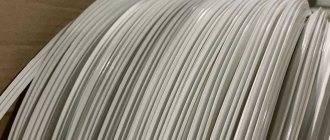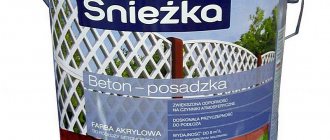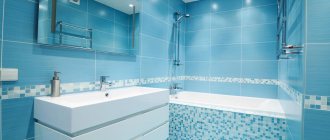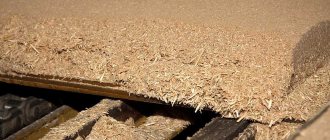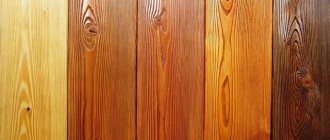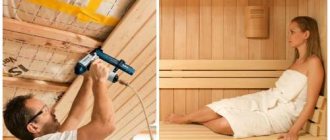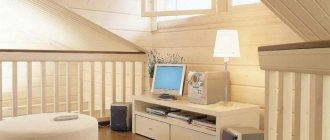Wood is a material that has long been used for cladding baths and saunas. It is there that wood best reveals its properties - the ability to create a microclimate and retain heat perfectly.
In truth, there is simply no alternative to wood for use in humid and hot environments. Accordingly, it is better to line the inside of the bathhouse with wooden clapboard. Below is the technology for step-by-step cladding of a bathhouse with clapboard inside.
Lining the bathhouse with wooden clapboard inside
Finishing a bathhouse or sauna with clapboard has its own characteristics that must be taken into account at the stage of selecting wood.
When choosing lining for cladding a bath, you need to consider:
- high temperature;
- temperature fluctuations (drops);
- humidity level;
- budget.
Material selection
Before you start work, you need to determine which lining to choose for the bathhouse. Wood is usually used. The main difference between the lining is the presence of a tongue-and-groove connection, thanks to which the boards fit more tightly to each other. This allows you to get a smooth and even surface, without cracks or gaps.
When choosing, first of all, you should decide on the type of wood. Hardwoods that are resistant to humid environments are mainly used. If you still want to make cladding from coniferous trees, it is important to choose species that do not emit resin. Not only will it stick to the skin, but it can also burn.
You can choose from the following breeds:
- Aspen . It tolerates temperature changes and high humidity well, and is easy to process. It has a white, slightly silvery color, with growth rings visible on the surface. Fresh aspen is soft, but becomes stronger. It must be sanded periodically when the lining becomes dull.
Aspen paneling Source saunainter.com
- Linden . When choosing which wood is best to cover a steam room in a bathhouse, many do not ignore linden. The material is easy to process, it is durable and beautiful - light, matte. At high temperatures it releases useful microparticles. However, linden has a serious drawback: upon contact with iron, the latter oxidizes and begins to rust.
- Alder . It has low thermal conductivity, a pleasant smell and a positive effect on health. Alder is often used in the decoration of country houses, but its price is high.
- Oak _ Durable and strong, difficult to process. It does not rot and does not need to be further processed for protection. It has a high price.
- Abashi or African oak . Durable, does not deform over time and is easy to process. This is an expensive cladding option, and African oak is also rare. But the service life of an abashi is calculated in decades.
Abashi trim Source tildacdn.com
- Larch . When deciding what can be used to line the inside of a bathhouse inexpensively, they most often stop at this. Unlike many conifers, it does not emit resin, tolerates temperature differences well, has a uniform structure, and only becomes stronger over time. Does not rot and does not attract insects. When heated, it releases useful antiseptic substances.
- Pine . Available in various shades of beige and brown, it usually has a reddish tint and pronounced growth rings with resin canals. It does not deform from mechanical damage, is easy to process - the surface is even and smooth. However, pine is not used for the steam room because of the resin it produces - it is used to line the dressing room, rest room and locker room. If you want to upholster the steam room with pine, before using it you need to heat it several times so that all the resin comes out.
- Cedar . It has different shades - from light beige to coffee. It withstands humidity and temperature changes and lasts a long time. Disadvantages include the high price and the need to treat the wood with an antiseptic. In addition, cedar may begin to secrete resin after a few years.
Finishing from Canadian cedar Source saunaland.ru
See also: Catalog of companies that specialize in finishing materials and related work
- Hemlock or Canadian hemlock . When choosing what to cover a bathhouse with, you should not ignore this wood. Canadian hemlock is durable, tolerates high humidity and temperature well, and is not subject to rot or deformation. When heated, it releases beneficial substances.
The appearance of the lining is extremely important: the boards must be smooth, without defects, holes and knots. It is better to choose the first or highest grade and eurolining. The latter has a smooth surface, is coated with an antiseptic and has special holes through which ventilation is provided.
What is the purpose of foil?
To achieve effective energy saving in a bathhouse, you will need to not only insulate it, but also use reflective material in the form of a special foil film. Masters claim that it helps return up to 95% of the heat into the room.
The result is that fuel for the stove is saved and the duration of the fire is reduced.
For baths, aluminum foil with a thickness of 30–300 microns is used. It is used in combination with other insulation or is already fixed as its top layer.
Therefore, before covering, they first attach insulating material to the walls and ceiling, thanks to which the heat does not escape beyond the bathhouse. An insulated steam room heats up faster and retains heat longer.
The following are the advantages of foil:
- It acts as a vapor barrier and blocks the access of moisture to the insulation. The generated steam remains on the walls of the steam room.
- Its service life exceeds 50 years. Wooden elements will begin to rot faster than the foil layer will deteriorate.
- Excellent sound insulation. Foil can absorb up to 70% of all sounds and noise.
- Fireproof raw materials. Does not burn. It will become an obstacle to the spread of fire.
- Bathrooms warm up faster and take longer to cool down.
- If you fix the insulation with a foil layer, then the foil will prevent it from falling off.
Among the disadvantages, the following should be noted:
- When there is a difference in temperature outside and indoors, condensation appears on the surface of the material.
- It is important to leave a gap for ventilation before covering. If this is not done, the resulting condensate will begin to be absorbed into the sheathing, which will lead to rotting of the lining.
- Foil has poor throughput. As users say, she is not breathing. Therefore, the rooms must have good ventilation, both forced and natural (windows, doors).
- Aluminum particles accumulate in the lungs, causing various respiratory diseases. But if you use the sauna periodically, the risk of harm to health is minimal.
To achieve the maximum effect from using foil, it is important to follow the tips for installing thermal insulation step by step.
Mounting options
Next, you need to choose how the lining will be attached. The planks are connected to each other by grooves, but they must also be attached to the sheathing.
You can do this in 2 ways:
- Using a clamper. This is a mounting bracket with 2-3 holes. It is put on the lining and fixed with nails, screws or staples. Installation begins from the center of the wall. Its main advantage is that the kleimer does not damage the lining.
- Using self-tapping screws or nails: the first ones are screwed in at an angle, the second ones are driven in. To avoid rust, it is better to choose galvanized or copper nails. Unfortunately, the metal will begin to rust, and leaks may also appear at the fastening sites.
Claymer for clapboard Source mainavi.ru
You can easily see how to properly line a bathhouse with clapboard from the inside with your own hands. The lining can be mounted horizontally or vertically. The first method is more suitable for saunas, where the humidity is low, the second - for Russian baths, where there is high humidity.
External characteristics
Depending on the purpose, the outer surface and shape of the wooden material can be made in various variations.
For the external cladding of a bathhouse, it is rational to choose wood in the form of a beam or a wide board. This form allows for perfect joining of individual elements, which prevents moisture from entering the cracks. External cladding of the bathhouse with wood that imitates a log will somewhat complicate the process of caring for the surface of the material.
Particular attention should be paid to how to attach the lining to the wall in the bathhouse. It is more rational to nail the lining to the frame using nails, since the use of special fasteners will incur additional costs.
Beginning of work
Installation begins with determining the amount of material required. When calculating the perimeter of a room, it is important to subtract doors and windows. Don't forget about the ceiling - it is also lined with clapboard. It is also necessary to account for a small percentage of defects: the boards can break and are easy to cut incorrectly.
Lathing
The lining will be attached to the sheathing - a frame that runs along all surfaces of the bathhouse. The sheathing is made of bars, the cross-section of which has the shape of a square or rectangle. You can use slats from any wood. Even if the frame is made of coniferous wood, the resin will not leak out.
The minimum thickness of the frame should be 3 cm - this will allow air to easily pass between the wall and the sheathing. The thickness should be greater than the thickness of the insulating material so as not to interfere with air flow. It is better to choose slats with a width of at least 5 cm, so that it is more convenient to attach the lining to them.
Russian bath
There are three types of baths in Russia, these are:
- Black bath;
- White bath;
- Camping sauna.
The first one is heated using birch firewood, which perfectly disinfects the air inside. After burning, be sure to ventilate the room from smoke and wash off the soot. The black bath has antiparasitic properties. Made from hardwood and softwood logs.
The next steam room is built from various materials (brick or stone). The stove can be made of stone or other rocks. The white bathhouse has a separate water tank, which is very convenient. Modern baths were built according to this type.
The camp sauna is popular among tourists. Constructed from branches and covered with polyethylene. Stones are placed inside and a fire is lit under them. It takes a long time to heat such a steam room, and the accumulated soot on the surface of the cellophane is very disturbing. It can get dirty.
Having listed the types of steam rooms, it is worth noting that most steam rooms in them are finished inside and outside with clapboard, since wood is the most convenient and natural in using a sauna. Whether to install eurolining or a cheaper option depends on the size of your funds.
Video description
How to sheathe the ceiling and sheathe it is shown in the video.
When considering how to sheathe the inside of a bathhouse, it is important to consider the first steps. The first block is fixed at a distance of 10 cm from the wall, the distance between the others should be 40-60 cm. During work, you need to check with a level whether the sheathing is level.
If the ceiling needs to be lowered, the slats are mounted on metal hangers.
Installation process
Installation of lining on a wall or ceiling takes place in several steps. Before starting work, it is recommended to keep the lining in a bathhouse for a day so that the material “adjusts” to the atmosphere.
It is necessary to start covering the walls from the most inaccessible corner, the ceiling - from the entrance. The first board is placed with the tenon towards the corner - it will serve as a guide, and therefore it is important that it is installed level. The rest are attached to her. The boards fit tightly to each other, leaving no gaps. The last board will need to be cut and adjusted to width. You will also need to attach the cut boards around the door and window.
At the end of the work, the walls can be impregnated with protective agents. When choosing, it is important to clarify whether they are suitable for a bath.
Lathing on the walls Source remontnik.ru
A couple of annoying mistakes
- First mistake. There is no honey without tar... Same with me - I didn’t take into account that moisture accumulating on the foil under the lining flows down, but I didn’t leave gaps so that it would flow onto the floor, and in winter the boards began to become damp. This did not happen in the summer, but in the winter it appeared as dark spots.
The moisture has nowhere to go - my problem.
The solution was simple:
- I trimmed the bottom edge with a circular saw and removed 4 cm;
- I drilled holes along the bottom edge directly above the bottom beam of the sheathing.
I’ll tell you more about this error in the video in the article.
- Second mistake. The sheathing should have started from the ceiling, but I started from the walls. This saves material and makes the work easier.
- Third mistake. Still, a gas silicate block is not the best solution for a bathhouse if it remains unfinished for a long time. In my case, it began to shrink, so something needs to be decided in the near future.
Briefly about the main thing
Wooden lining for lining the inside of a bathhouse is an ideal finishing material. Deciduous trees are mainly used, since coniferous trees can begin to secrete resin.
Installation of the lining begins with determining the required amount of material and method of fastening. It is worth considering the small percentage of defects.
First, you need to attach a sheathing to the wall - a frame on which the lining will be supported. It is made from thick wooden slats.
Next, the insulation, waterproofing and vapor barrier are secured. When choosing materials, it is important that they are suitable for the bath and do not emit harmful substances when heated.
When installing the boards, they are fitted tightly to each other so that there are no gaps.
Ratings 0
Installation methods
Vertical and horizontal fastening of the lining
The material consists of long, narrow lamellas. Their location on the wall greatly influences visual perception. The following methods are used in the bath.
- Horizontal - visually expands the room, but makes it slightly lower. Quite suitable for large steam rooms. In addition, this position of the lamellas prevents drying out and deformation of the wood.
- Vertical - visually raises the ceiling, so it is used more often. However, from a practical point of view, the method is less profitable. The boards in the lower and upper parts are subject to different thermal loads, which leads to deformation.
The diagonal placement method is rare. It looks beautiful, but requires a lot of material consumption and maintenance.
Thermal insulation (insulation)
Let’s make a reservation right away: it is not necessary to completely insulate the walls. Especially if you have a summer bathhouse with dimensions of 3x3 m. When a classic “Russian bathhouse” is assumed, insulation is necessary (in all zones).
Any material that is not prone to fire can act as a thermal insulator. For example, mineral wool (basalt). Any semblance of polystyrene foam is strictly excluded.
The insulation layer is fixed on the sheathing (prepare in advance). On top of the insulation is a vapor barrier made of aluminum foil. It will protect the insulation from condensation, which invariably accumulates on the walls. The reason is temperature fluctuations and humidity. Foil perfectly reflects thermal radiation and blocks water vapor. To fix the vapor barrier, use buttons or staples for a stapler. The overlap width when installing foil is 10-15 cm.
Important: First of all, vapor barrier is done on the walls, and only then they move on to the ceiling. This is done so that the condensation that will collect on the ceiling and walls flows smoothly down and does not get into the insulation.
Treatment of lining with protective agents
Sheathed walls are subjected to protective treatment.
Solutions that are water-based or contain wax are considered the safest to use. They are environmentally friendly and harmless to health. A waterproof film is formed on the surface of the lining, which prevents moisture from penetrating into the wood, extending its service life.
Before application, it is important to read the manufacturer's instructions. Often applying the product even in one layer is enough.
Using wooden paneling to cover the bathhouse, the owners create a special microclimate inside the room, which has a positive effect on the health of vacationers. Plus, wood is a natural material that fits perfectly into the interior decoration of the bathhouse, looks beautiful and smells nice.

